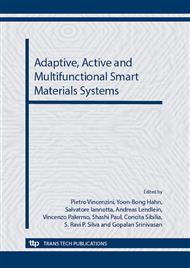p.146
p.153
p.159
p.165
p.172
p.178
p.184
p.190
p.196
Surface Modification of High Internal Phase Emulsion Foam as a Scaffold for Tissue Engineering Application via Atmospheric Pressure Plasma Treatment
Abstract:
Atmospheric pressure plasma treatment was used to improve hydrophilic properties and scaffold/cell interaction of poly(S/EGDMA)polyHIPE highly porous foam, prepared from poly(styrene/ethylene glycol dimethacrylate) using high internal phase emulsion technique. With our synthesis procedure and surface treatment, this bioactive material, featuring highly porous structure and good mechanical strength, can be applied as a scaffold for tissue engineering applications. The treatment time and external plasma parameters were investigated in regards to the polyHIPE foam surface’s appropriate for fibroblast implantation. The changes in surface properties were characterized by contact angle measurement, showing that the exposure to air-plasma induced polyHIPE foam with hydrophilic surfaces, as observed by a decrease in contact angle degree. Enhancement of the interaction between the polyHIPE foam and the L929 fibroblast-like cells would imply the hydrophilic improvement of the polyHIPE foam surface due to the polar-like property of the biofluid cell medium.
Info:
Periodical:
Pages:
172-177
Citation:
Online since:
September 2012
Price:
Сopyright:
© 2013 Trans Tech Publications Ltd. All Rights Reserved
Share:
Citation:


